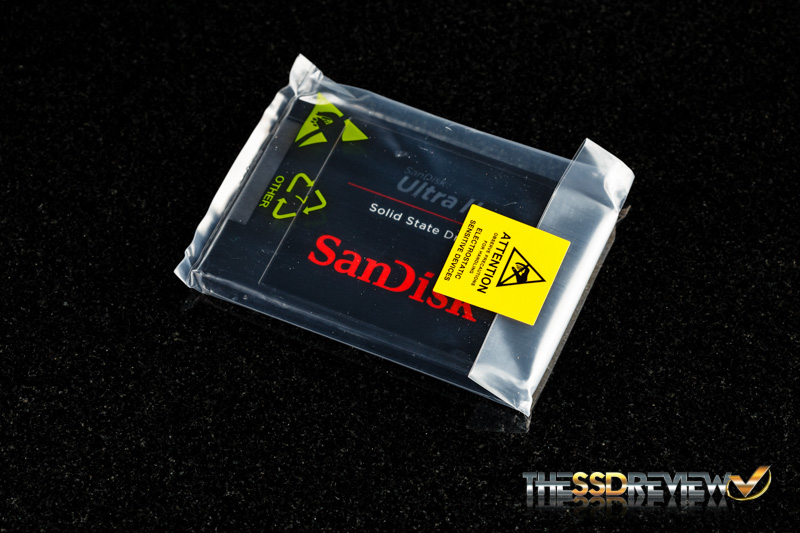SANDISK ULTRA II SSD PACKAGING AND COMPONENTS
Our review sample did not come in retail packaging. Instead we received a reviewer’s kit. The drive itself was enclosed in an anti-static bag as pictured below.
The makeup of the case consists of half plastic and half metal, making the touch and sight to be sleek and bold. Furthermore, the design enhances the nice black and red contrast of the SanDisk. The overall weight is light, coming in at 58 grams.
Pictured below is the front and back of the PCB. SanDisk PCB’s really stand out compared to most of the market with their blue color.
As you can see, the PCB is very small as well. On it are just four SanDisk NAND packages, a single SK Hynix DRAM chip and a Marvell controller.
The Marvell controller is a new Marvell 88SS9190. This is a brand new 4 channel controller; there is absolutely nothing on the internet about it. From what it seems, it is similar to the previous Marvell 88SS9189 controller, as it has thermal throttling and DevSleep support. The 480GB and 960GB models have an 8 channel controller.
Above to the left is a close up of SanDisk’s 1Ynm, X3 ABL, Toggle NAND. It is 19nm 128Gbit TLC (3-bit). In total there are 4 NAND packages in 64GB capacity each. When formatted there is a usable capacity of 223GB. Next to it is a 256MB SK Hynix DDR3 DRAM chip running at 667MHz. The 120GB, 480GB, and 960GB drives use 128MB, 512MB, and 1024MB respectively. SanDisk also mentioned that they are not entitled to one source for the DRAM; other DRAM chips can be from Nanya, Micron, etc.
 The SSD Review The Worlds Dedicated SSD Education and Review Resource |
The SSD Review The Worlds Dedicated SSD Education and Review Resource | 


> write speeds dropped to around 240MB/s. This is still pretty good,
especially considering it is such a compact design with only four TLC
NAND packages.
I wonder how other capacities perform. This kind of write is avarage at best, since even older 840 topped that.
But, if this is priced right, its a great alternative to MX100. Lets just hope this thing doesn’t have the same issues as 840 and 840EVO, as those drives experince quite a drop in read performance on cold files. Its actually an issue, that many have nowdays.
I wonder as well. And yes, I believe this drive is a great alternative to the MX100.
I have taken note of the 840 cold files issue when it first appeared as well, it is a little disappointing. Hopefully a simple F/W update can fix it. Otherwise, I am pondering if it could be a TLC NAND cause.
I suspect (again, i’m only making wild guesses here) it has to be TLC, since its only limited to 840/840evo, while 840pro is not affected. Given how many states TLC must hold and very small litography its quite possible, that data retention is dropping faster than we though. Or it could be something entirely different.